the roadmap of python for developer beginner
Download as PPTX, PDF0 likes16 views
the roadmap of python for learning purpose
1 of 11
Download to read offline


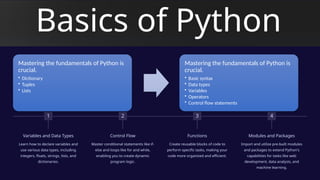
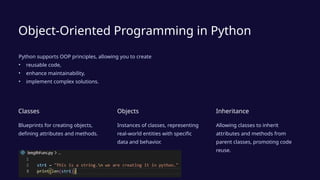
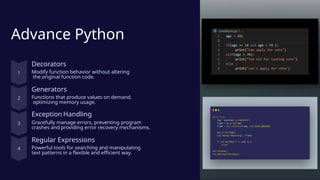
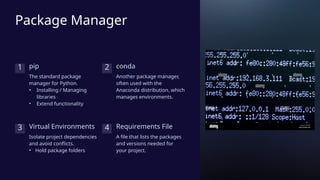

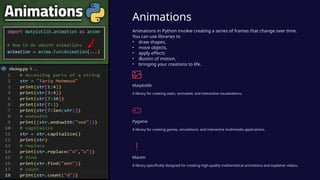
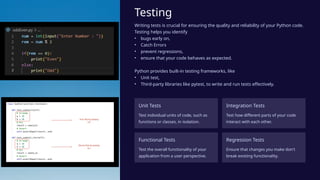


Recommended
From Basics to Advanced: A Comprehensive Python Programming Guide



From Basics to Advanced: A Comprehensive Python Programming Guidepallavichauhan2525
╠²
Python's strength lies in its versatility and simplicity. Whether youŌĆÖre developing small automation scripts or large-scale machine learning applications, Python provides the right tools to simplify your tasks. Its expansive library ecosystem, active community, and diverse applications make Python the language of choice for many developers.
Basic Course Under Python Programming Course



Basic Course Under Python Programming Coursekhushbhatti511
╠²
"Master Python programming with this comprehensive course, covering core concepts, data structures, and practical applications. Perfect for beginners and those looking to enhance their coding skills."DEMO On PYTHON WEB Development.pptx



DEMO On PYTHON WEB Development.pptxSHAIKIRFAN715544
╠²
This document provides information about a demo on Python web development presented by Shaik Irfan. It includes details about the presenter's qualifications and experience. It then discusses front-end and back-end web development. The rest of the document outlines the course contents which cover Python fundamentals, databases, GUI development, APIs, front-end technologies and the Django framework. It also lists some common career paths that involve Python like data analysis, cyber security, machine learning and database administration.Python programming ppt.pptx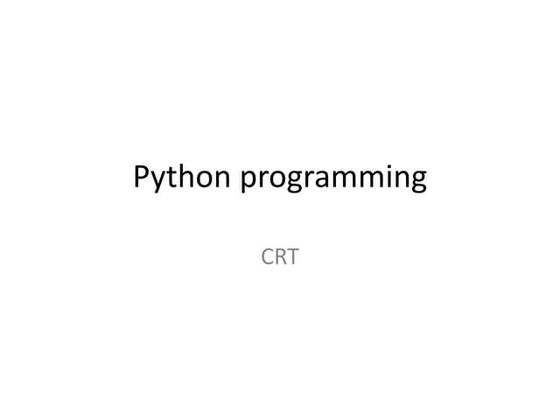



Python programming ppt.pptxnagendrasai12
╠²
Python is a versatile and widely-used high-level programming language known for its simplicity, readability, and extensive library support. Created by Guido van Rossum and first released in 1991, Python has since gained immense popularity across various domains, including web development, data science, scientific computing, artificial intelligence, and more. In this comprehensive description, we'll delve into Python's history, features, applications, and its vibrant community, highlighting why it continues to be a preferred choice for developers worldwide.
Table of Contents
Introduction to Python
Python's History and Evolution
Python's Key Features
3.1. Readability and Simplicity
3.2. High-level Language
3.3. Interpreted and Dynamic
3.4. Cross-platform Compatibility
3.5. Rich Standard Library
3.6. Community Support
Python's Application Domains
4.1. Web Development
4.2. Data Science and Machine Learning
4.3. Scientific Computing
4.4. Automation and Scripting
4.5. Game Development
4.6. Desktop Applications
Python Development Environments
5.1. IDLE
5.2. PyCharm
5.3. Jupyter Notebook
5.4. Visual Studio Code
Getting Started with Python
6.1. Installing Python
6.2. Your First Python Program
Python Syntax and Basic Concepts
7.1. Variables and Data Types
7.2. Conditional Statements
7.3. Loops
7.4. Functions
7.5. Exception Handling
Working with Python Libraries
8.1. NumPy
8.2. Pandas
8.3. Matplotlib
8.4. Scikit-Learn
Python and Web Development
9.1. Frameworks (Django, Flask)
9.2. Front-end Integration (HTML/CSS)
9.3. Database Interaction (SQL, NoSQL)
Python in Data Science
10.1. Data Analysis with Pandas
10.2. Data Visualization with Matplotlib and Seaborn
10.3. Machine Learning with Scikit-Learn
10.4. Deep Learning with TensorFlow and PyTorch
Scientific Computing with Python
11.1. Scientific Libraries (SciPy, SymPy)
11.2. Plotting and Visualization (Matplotlib)
Automation and Scripting
12.1. Automating Tasks
12.2. Scripting for System Administration
Game Development with Python
13.1. Pygame
13.2. Unity and Unreal Engine Integration
Desktop Applications with Python
14.1. Tkinter
14.2. PyQt
Python's Ecosystem and Package Management
Python Best Practices
16.1. Code Readability (PEP 8)
16.2. Documentation and Comments
16.3. Testing (Unit Testing, pytest)
16.4. Version Control (Git)
Python's Future and Trends
Conclusion
1. Introduction to Python
Python is a general-purpose, high-level programming language that was designed with a focus on code readability and simplicity. It uses an elegant and straightforward syntax that makes it easy for developers to express their ideas effectively, reducing the cost of program maintenance. Python's philosophy emphasizes the importance of code clarity and readability, which is encapsulated in the Zen of Python (PEP 20).
The language has gained immense popularity due to its versatility and a rich ecosystem of libraries and frameworks. Python is renowned for its vibrant community and extensive documentation, making it in pPYTHON UNIT 1



PYTHON UNIT 1nagendrasai12
╠²
Certainly! Here's a detailed 3000-word description of Python:
# Python: A Comprehensive Overview
Python is a high-level, versatile, and dynamically-typed programming language known for its simplicity and readability. Created by Guido van Rossum in the late 1980s, Python has since become one of the most popular programming languages worldwide. In this comprehensive overview, we will delve into the key aspects of Python, from its history and design philosophy to its syntax, libraries, and real-world applications.
## **History and Evolution of Python**
Python's history dates back to December 1989 when Guido van Rossum, a Dutch programmer, began working on it as a side project during his Christmas holidays. His aim was to create a language that emphasized code readability and allowed developers to express their ideas in fewer lines of code compared to other languages like C++ or Perl.
The first official Python release, Python 0.9.0, was released in February 1991. Python's name was inspired by Guido's love for the British comedy group Monty Python. Despite its humorous origins, Python quickly gained popularity in the software development community.
Python's major versions include Python 1.0 (1994), Python 2.0 (2000), Python 3.0 (2008), and the subsequent 3.x releases. The transition from Python 2 to Python 3 was a significant milestone in Python's history, as it involved breaking compatibility with Python 2 to introduce improvements and address some language inconsistencies. Python 2 reached its end of life on January 1, 2020, and Python 3 is now the standard and recommended version for new projects.
## **Design Philosophy: The Zen of Python**
Python's success can be attributed, in part, to its clear and guiding design principles, often referred to as "The Zen of Python" or "PEP 20" (Python Enhancement Proposal 20). These principles encapsulate the language's philosophy and provide a framework for writing clean, readable, and maintainable code. Some notable principles from "The Zen of Python" include:
- **Readability Counts:** Code should be easy to read and understand. Python's syntax enforces this with its use of indentation for block structure.
- **Simple is Better Than Complex:** Python encourages simplicity in both code design and implementation. It favors straightforward solutions over convoluted ones.
- **Explicit is Better Than Implicit:** Code should be explicit and not rely on hidden or magical behavior. This principle promotes code clarity and predictability.
- **There Should Be One-- and Preferably Only One --Obvious Way to Do It:** Python aims to provide a single, clear way to perform a specific task to reduce confusion and make code more consistent.
- **Errors Should Never Pass Silently:** Python encourages robust error handling and reporting to help developers identify and fix issues promptly.
## **Python Syntax and Language Features**
Python's syntax is known for its simplicity and readability. Here are some key languagIntroduction to Python Programming Basics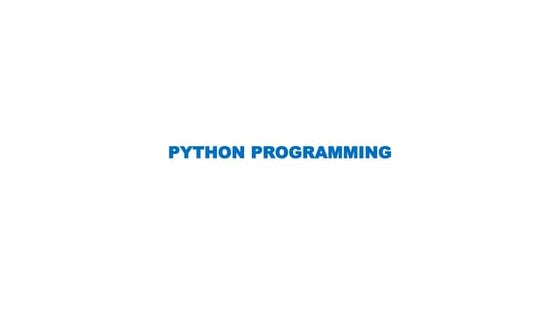



Introduction to Python Programming BasicsDhana malar
╠²
Python is a popular high-level programming language that can be used for a wide range of applications from simple scripts to complex machine learning programs. It has a simple syntax, extensive standard library, and support for code reuse through modules and packages. Some key strengths of Python include its huge collection of standard libraries for tasks like machine learning, web development, scientific computing, and more. It is also an interpreted language, making it easy to learn and use for both simple and complex programming tasks.Python & Django



Python & DjangoAllan114858
╠²
Python is a popular high-level programming language known for its readability and simplicity. It has dynamic semantics, automatic memory management, and supports object-oriented, imperative, and functional programming. Django is a Python web framework that follows the MVC pattern and emphasizes reusability. It includes an ORM, automatic admin interface, template engine, and security features to enable rapid development of secure websites.Python Programming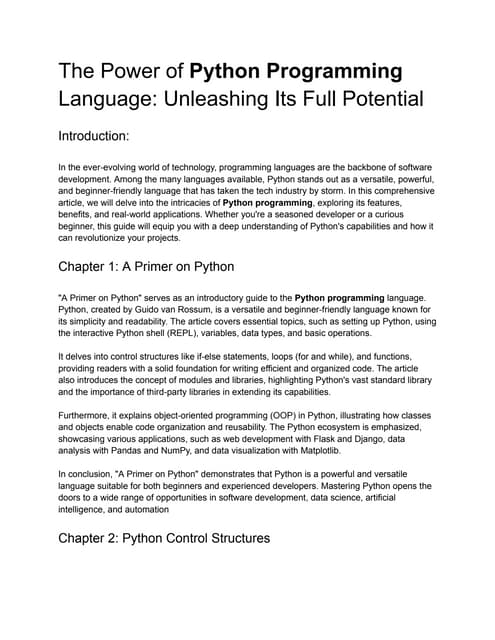



Python ProgrammingSheikAllavudeenN
╠²
Python is a widely-used, high-level programming language known for its simplicity, readability, and extensive library support. It is favored by developers for its ease of use and ability to handle diverse tasks, making it suitable for various applications ranging from web development to data analysis and artificial intelligence.Python programming language introduction unit



Python programming language introduction unitmichaelaaron25322
╠²
This document provides an introduction to Python programming. It discusses the history and origins of Python, its key features and applications. Some of the main points covered include:
- Python was created in the late 1980s by Guido van Rossum and takes influence from other languages like ABC, Modula-3, C, C++ and Unix shell scripts.
- Python is an interpreted, object-oriented scripting language that is designed to be highly readable. It has applications in systems programming, GUIs, web development, data analysis, scientific computing and more.
- The document outlines Python's technical strengths like being free, portable, powerful, easy to use and learn. It also covers basics like variables,Python-Mastering-the-Language-of-Data-Science.pptx



Python-Mastering-the-Language-of-Data-Science.pptxdmdHaneef
╠²
This presentation provides an introduction to the Python programming language. It covers Python's basics like data types, variables, conditional statements, loops, functions, modules, file handling, object-oriented programming concepts, and popular Python libraries for data science like Pandas, Django, and Numpy. The goal is to give attendees a solid understanding of Python and how it is used widely in fields like data science, machine learning, and artificial intelligence.Roadmap To Become A Python Developer.pptx



Roadmap To Become A Python Developer.pptxDeepakGarhwal2
╠²
learning python could be super easy if you have a complete roadmap so here, in this presentation, we will explore the detailed roadmap to become a Python developer.
A deep dive into python and it's position in the programming landscape.pptx



A deep dive into python and it's position in the programming landscape.pptxMurugan Murugan
╠²
Introduction to pythonWhat is python



What is pythonfaizrashid1995
╠²
Python is an easy to learn programming language that is widely used for a variety of tasks. It has a simple syntax that allows developers to focus on solving problems rather than dealing with complex language features. Python code can be written quickly and read easily by others. It also has a large ecosystem of libraries and frameworks that support application development, data science, machine learning, and more. While not the fastest language, Python makes up for it with versatility and the ability to connect different systems through its "glue" programming capabilities.Python Certification Course In Hyderabad



Python Certification Course In Hyderabadarunbp448
╠²
A Python course is designed to teach individuals the fundamentals and advanced concepts of Python programming. It covers topics such as syntax, data types, control structures, functions, modules, and libraries. Students learn how to write efficient and readable code, debug programs, and implement algorithms. The course often includes practical exercises, projects, and real-world applications to solidify understanding. Python's versatility and simplicity make it a popular choice for beginners and professionals in fields like data science, web development, automation, and artificial intelligence. By completing a Python course, learners gain essential skills for various tech careers.
Certified Python Developer Courses in Mumbai



Certified Python Developer Courses in Mumbaiarunbp448
╠²
A Python course is designed to teach individuals the fundamentals and advanced concepts of Python programming. It covers topics such as syntax, data types, control structures, functions, modules, and libraries. Students learn how to write efficient and readable code, debug programs, and implement algorithms. The course often includes practical exercises, projects, and real-world applications to solidify understanding. Python's versatility and simplicity make it a popular choice for beginners and professionals in fields like data science, web development, automation, and artificial intelligence. By completing a Python course, learners gain essential skills for various tech careers.Python Programming Certification Course In Pune



Python Programming Certification Course In Punearunbp448
╠²
A Python course is designed to teach individuals the fundamentals and advanced concepts of Python programming. The course often includes practical exercises, projects, and real-world applications to solidify understanding.
For more information: https://datamites.com/python-certification-course-training-pune/Python Certification courses in Ahmedabad



Python Certification courses in Ahmedabadarunbp448
╠²
A Python course is designed to teach individuals the fundamentals and advanced concepts of Python programming. The course often includes practical exercises, projects, and real-world applications to solidify understanding.
For more information: https://datamites.com/python-certification-course-training-ahmedabad/
Certified Python Programming Course in Delhi



Certified Python Programming Course in Delhiarunbp448
╠²
A Python course is designed to teach individuals the fundamentals and advanced concepts of Python programming.The course often includes practical exercises, projects, and real-world applications to solidify understanding.
For more information: https://datamites.com/python-certification-course-training-delhi/
Certified Python Training Course in Bhubaneshwar



Certified Python Training Course in Bhubaneshwararunbp448
╠²
A Python course is designed to teach individuals the fundamentals and advanced concepts of Python programming.The course often includes practical exercises, projects, and real-world applications to solidify understanding.
For more information: https://datamites.com/python-certification-course-training-bhubaneswar/
Certified Python Training Courses in Chennai



Certified Python Training Courses in Chennaiarunbp448
╠²
A Python course is designed to teach individuals the fundamentals and advanced concepts of Python programming. The course often includes practical exercises, projects, and real-world applications to solidify understanding.
For more information: https://datamites.com/python-certification-course-training-chennai/Python Certification Course in Bangalore



Python Certification Course in Bangalorearunbp448
╠²
A Python course is designed to teach individuals the fundamentals and advanced concepts of Python programming.The course often includes practical exercises, projects, and real-world applications to solidify understanding.
For more information:https://datamites.com/python-certification-course-training-bangalore/
Best-Python-Training-Course-In-Zirakpur (1).pptx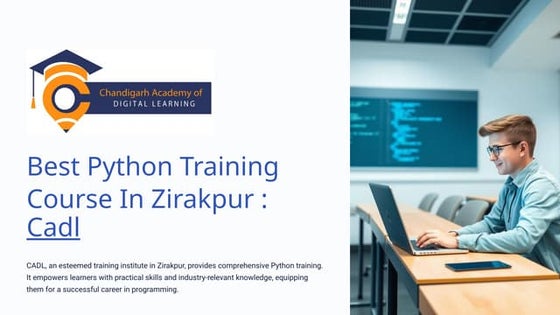



Best-Python-Training-Course-In-Zirakpur (1).pptxwatapom559
╠²
CADL offers the Best Python Training Course in Zirakpur, designed for beginners and professionals alike. The course covers essential Python programming concepts, hands-on coding exercises, real-world projects, and personalized guidance. With experienced instructors and a practical approach, CADL ensures that students gain the skills needed to excel in Python development and advance their careers.Python programming courses in coimbatore



Python programming courses in coimbatoremkriti132
╠²
DataMites offers comprehensive Python programming courses in Coimbatore, with flexible learning options and certification, DataMites equips learners with the necessary skills to thrive in the tech industry.What Is The BEST WAY TO LEARN PYTHON In 2023.pptx



What Is The BEST WAY TO LEARN PYTHON In 2023.pptxcalltutors
╠²
Want to learn python but don;t know how? don;t worry! read our blog to know the best way to learn python in 2023 with complete guide.Codequiry: A Code Similarity Checker Every Developer Should Know



Codequiry: A Code Similarity Checker Every Developer Should KnowCode Quiry
╠²
Every developer values originalityŌĆöand Codequiry makes it easy to protect it. This powerful code similarity checker analyzes structure, logic, and syntax to detect plagiarism with precision. With support for 50+ programming languages and in-depth comparison across web, peer, and internal sources, Codequiry is an essential tool for anyone serious about writing clean, authentic, and uncompromised code.Health Promotion explained ppt.pptx



Health Promotion explained ppt.pptxMohamedIbrahim354734
╠²
This is a seminar on health promotion, hope it will help you understanding the topicMore Related Content
Similar to the roadmap of python for developer beginner (20)
Python & Django



Python & DjangoAllan114858
╠²
Python is a popular high-level programming language known for its readability and simplicity. It has dynamic semantics, automatic memory management, and supports object-oriented, imperative, and functional programming. Django is a Python web framework that follows the MVC pattern and emphasizes reusability. It includes an ORM, automatic admin interface, template engine, and security features to enable rapid development of secure websites.Python Programming



Python ProgrammingSheikAllavudeenN
╠²
Python is a widely-used, high-level programming language known for its simplicity, readability, and extensive library support. It is favored by developers for its ease of use and ability to handle diverse tasks, making it suitable for various applications ranging from web development to data analysis and artificial intelligence.Python programming language introduction unit



Python programming language introduction unitmichaelaaron25322
╠²
This document provides an introduction to Python programming. It discusses the history and origins of Python, its key features and applications. Some of the main points covered include:
- Python was created in the late 1980s by Guido van Rossum and takes influence from other languages like ABC, Modula-3, C, C++ and Unix shell scripts.
- Python is an interpreted, object-oriented scripting language that is designed to be highly readable. It has applications in systems programming, GUIs, web development, data analysis, scientific computing and more.
- The document outlines Python's technical strengths like being free, portable, powerful, easy to use and learn. It also covers basics like variables,Python-Mastering-the-Language-of-Data-Science.pptx



Python-Mastering-the-Language-of-Data-Science.pptxdmdHaneef
╠²
This presentation provides an introduction to the Python programming language. It covers Python's basics like data types, variables, conditional statements, loops, functions, modules, file handling, object-oriented programming concepts, and popular Python libraries for data science like Pandas, Django, and Numpy. The goal is to give attendees a solid understanding of Python and how it is used widely in fields like data science, machine learning, and artificial intelligence.Roadmap To Become A Python Developer.pptx



Roadmap To Become A Python Developer.pptxDeepakGarhwal2
╠²
learning python could be super easy if you have a complete roadmap so here, in this presentation, we will explore the detailed roadmap to become a Python developer.
A deep dive into python and it's position in the programming landscape.pptx



A deep dive into python and it's position in the programming landscape.pptxMurugan Murugan
╠²
Introduction to pythonWhat is python



What is pythonfaizrashid1995
╠²
Python is an easy to learn programming language that is widely used for a variety of tasks. It has a simple syntax that allows developers to focus on solving problems rather than dealing with complex language features. Python code can be written quickly and read easily by others. It also has a large ecosystem of libraries and frameworks that support application development, data science, machine learning, and more. While not the fastest language, Python makes up for it with versatility and the ability to connect different systems through its "glue" programming capabilities.Python Certification Course In Hyderabad



Python Certification Course In Hyderabadarunbp448
╠²
A Python course is designed to teach individuals the fundamentals and advanced concepts of Python programming. It covers topics such as syntax, data types, control structures, functions, modules, and libraries. Students learn how to write efficient and readable code, debug programs, and implement algorithms. The course often includes practical exercises, projects, and real-world applications to solidify understanding. Python's versatility and simplicity make it a popular choice for beginners and professionals in fields like data science, web development, automation, and artificial intelligence. By completing a Python course, learners gain essential skills for various tech careers.
Certified Python Developer Courses in Mumbai



Certified Python Developer Courses in Mumbaiarunbp448
╠²
A Python course is designed to teach individuals the fundamentals and advanced concepts of Python programming. It covers topics such as syntax, data types, control structures, functions, modules, and libraries. Students learn how to write efficient and readable code, debug programs, and implement algorithms. The course often includes practical exercises, projects, and real-world applications to solidify understanding. Python's versatility and simplicity make it a popular choice for beginners and professionals in fields like data science, web development, automation, and artificial intelligence. By completing a Python course, learners gain essential skills for various tech careers.Python Programming Certification Course In Pune



Python Programming Certification Course In Punearunbp448
╠²
A Python course is designed to teach individuals the fundamentals and advanced concepts of Python programming. The course often includes practical exercises, projects, and real-world applications to solidify understanding.
For more information: https://datamites.com/python-certification-course-training-pune/Python Certification courses in Ahmedabad



Python Certification courses in Ahmedabadarunbp448
╠²
A Python course is designed to teach individuals the fundamentals and advanced concepts of Python programming. The course often includes practical exercises, projects, and real-world applications to solidify understanding.
For more information: https://datamites.com/python-certification-course-training-ahmedabad/
Certified Python Programming Course in Delhi



Certified Python Programming Course in Delhiarunbp448
╠²
A Python course is designed to teach individuals the fundamentals and advanced concepts of Python programming.The course often includes practical exercises, projects, and real-world applications to solidify understanding.
For more information: https://datamites.com/python-certification-course-training-delhi/
Certified Python Training Course in Bhubaneshwar



Certified Python Training Course in Bhubaneshwararunbp448
╠²
A Python course is designed to teach individuals the fundamentals and advanced concepts of Python programming.The course often includes practical exercises, projects, and real-world applications to solidify understanding.
For more information: https://datamites.com/python-certification-course-training-bhubaneswar/
Certified Python Training Courses in Chennai



Certified Python Training Courses in Chennaiarunbp448
╠²
A Python course is designed to teach individuals the fundamentals and advanced concepts of Python programming. The course often includes practical exercises, projects, and real-world applications to solidify understanding.
For more information: https://datamites.com/python-certification-course-training-chennai/Python Certification Course in Bangalore



Python Certification Course in Bangalorearunbp448
╠²
A Python course is designed to teach individuals the fundamentals and advanced concepts of Python programming.The course often includes practical exercises, projects, and real-world applications to solidify understanding.
For more information:https://datamites.com/python-certification-course-training-bangalore/
Best-Python-Training-Course-In-Zirakpur (1).pptx



Best-Python-Training-Course-In-Zirakpur (1).pptxwatapom559
╠²
CADL offers the Best Python Training Course in Zirakpur, designed for beginners and professionals alike. The course covers essential Python programming concepts, hands-on coding exercises, real-world projects, and personalized guidance. With experienced instructors and a practical approach, CADL ensures that students gain the skills needed to excel in Python development and advance their careers.Python programming courses in coimbatore



Python programming courses in coimbatoremkriti132
╠²
DataMites offers comprehensive Python programming courses in Coimbatore, with flexible learning options and certification, DataMites equips learners with the necessary skills to thrive in the tech industry.What Is The BEST WAY TO LEARN PYTHON In 2023.pptx



What Is The BEST WAY TO LEARN PYTHON In 2023.pptxcalltutors
╠²
Want to learn python but don;t know how? don;t worry! read our blog to know the best way to learn python in 2023 with complete guide.Recently uploaded (20)
Codequiry: A Code Similarity Checker Every Developer Should Know



Codequiry: A Code Similarity Checker Every Developer Should KnowCode Quiry
╠²
Every developer values originalityŌĆöand Codequiry makes it easy to protect it. This powerful code similarity checker analyzes structure, logic, and syntax to detect plagiarism with precision. With support for 50+ programming languages and in-depth comparison across web, peer, and internal sources, Codequiry is an essential tool for anyone serious about writing clean, authentic, and uncompromised code.Health Promotion explained ppt.pptx



Health Promotion explained ppt.pptxMohamedIbrahim354734
╠²
This is a seminar on health promotion, hope it will help you understanding the topicScotSecure Cyber Security Summit 2025 Edinburgh



ScotSecure Cyber Security Summit 2025 EdinburghRay Bugg
╠²
Scot-Secure is ScotlandŌĆÖs largest annual cyber security conference. The event brings together senior InfoSec personnel, IT leaders, academics, security researchers and law enforcement, providing a unique forum for knowledge exchange, discussion and high-level networking.
The programme is focussed on improving awareness and best practice through shared learning: highlighting emerging threats, new research and changing adversarial tactics, and examining practical ways to improve resilience, detection and response.TrustArc Webinar - Data Privacy and Cyber Security: A Symbiotic Relationship



TrustArc Webinar - Data Privacy and Cyber Security: A Symbiotic RelationshipTrustArc
╠²
In todayŌĆÖs digital age, data has become an organizationŌĆÖs lifeblood. As the use of digital technologies continues to escalate, so do the risks associated with personal data, which continue to grow exponentially as well. To effectively safeguard personal and sensitive information, organizations must understand the intricate relationship between data privacy, cybersecurity, and incident response.
Data privacy and cybersecurity are two sides of the same coin. Data privacy focuses on how personal data is to be collected, used, stored, shared and controlled, while cybersecurity aims to protect systems and networks from unauthorized access, digital attacks, malware and data breaches.
However, even with the best data privacy and security measures in place, cyber incidents can still occur. A well-prepared incident response plan is crucial for minimizing the impact of a breach and restoring normal operations.
Join our experts on this webinar to discuss how data privacy, cybersecurity, and incident response interact and are essential for safeguarding your organizationŌĆÖs digital assets.
This webinar will review:
- How data privacy and cybersecurity intersect
- How to develop a comprehensive privacy and security strategy to safeguard personal and sensitive information
- What are suggestions and expectations around incident responseAutomating Behavior-Driven Development: Boosting Productivity with Template-D...



Automating Behavior-Driven Development: Boosting Productivity with Template-D...DOCOMO Innovations, Inc.
╠²
https://bit.ly/4ciP3mZ
We have successfully established our development process for Drupal custom modules, including automated testing using PHPUnit, all managed through our own GitLab CI/CD pipeline. This setup mirrors the automated testing process used by Drupal.org, which was our goal to emulate.
Building on this success, we have taken the next step by learning Behavior-Driven Development (BDD) using Behat. This approach allows us to automate the execution of acceptance tests for our Cloud Orchestration modules. Our upcoming session will provide a thorough explanation of the practical application of Behat, demonstrating how to effectively use this tool to write and execute comprehensive test scenarios.
In this session, we will cover:
1. Introduction to Behavior-Driven Development (BDD):
- Understanding the principles of BDD and its advantages in the software development lifecycle.
- How BDD aligns with agile methodologies and enhances collaboration between developers, testers, and stakeholders.
2. Overview of Behat:
- Introduction to Behat as a testing framework for BDD.
- Key features of Behat and its integration with other tools and platforms.
3. Automating Acceptance Tests:
- Running Behat tests in our GitLab CI/CD pipeline.
- Techniques for ensuring that automated tests are reliable and maintainable.
- Strategies for continuous improvement and scaling the test suite.
4. Template-Based Test Scenario Reusability:
- How to create reusable test scenario templates in Behat.
- Methods for parameterizing test scenarios to enhance reusability and reduce redundancy.
- Practical examples of how to implement and manage these templates within your testing framework.
By the end of the session, attendees will have a comprehensive understanding of how to leverage Behat for BDD in their own projects, particularly within the context of Drupal and cloud orchestration. They will gain practical knowledge on writing and running automated acceptance tests, ultimately enhancing the quality and efficiency of their development processes.Build With AI X GDG Harare Beginners .pdf



Build With AI X GDG Harare Beginners .pdfGoogle Developer Group - Harare
╠²
This slide is from a Build with AI beginner workshop that was hosted by Google Developer Groups Harare. It takes you through a step by step approach to creating a multiple speaker podcast using Google Cloud and the Gemini API. . It also details how the Gemma models can be used to build different applications and solutions.AI Driven Posture Analysis Fall Detection System for the Elderly.pdf



AI Driven Posture Analysis Fall Detection System for the Elderly.pdfPatrick Ogbuitepu
╠²
This project introduces an innovative, cost-effective solution for real-time activity monitoring of elderly individuals. By leveraging the MediaPipe pose estimation model, fuzzy logic, and finite state machines, the system can reliably track individuals, recognize static postures (standing, sitting, lying), and detect transitions, particularly focusing on falls. A key achievement is the systemŌĆÖs zero false alarm rate, a significant advancement in vision-based fall detection systems. While the system shows promise, it faces limitations in scenarios with severe occlusions or low lighting conditions. To address these challenges, future work
will explore the use of multi-camera setups, interactive calibration modes, and audio feedback to enhance accuracy and user experience. This prototype represents a significant step towards reliable, real-time elder care. By combining advanced AI techniques with practical considerations, this system offers a scalable and effective solution to a pressing societal need.Introduction to Generative AI refers to a subset of artificial intelligence



Introduction to Generative AI refers to a subset of artificial intelligenceKongu Engineering College, Perundurai, Erode
╠²
Generative AI refers to a subset of artificial intelligence that focuses on creating new content, such as images, text, music, and even videos, based on the data it has been trained on. Generative AI models learn patterns from large datasets and use these patterns to generate new content. Handout - Demonolithing Think Again (Devoxx GR 2025).pdf



Handout - Demonolithing Think Again (Devoxx GR 2025).pdfScott Sosna
╠²
Your application has advanced from "legacy" to "unmaintainable"? Corporate leaders believe it's not _that_ bad and can be migrated into a new, exciting architecture? Yeah, right. Learn the types of problems you're likely to run into, and how likely you'll never complete the demonolithing your organization is banking on.Human Centered Design By Gnanasambandham



Human Centered Design By GnanasambandhamGnanasambandham Anbazhagan CSP, CSM, CSPO
╠²
Human Centered Design By GnanasambandhamMisc: The Internet Story - How Data Travels, Transit Works, and the Role of C...



Misc: The Internet Story - How Data Travels, Transit Works, and the Role of C...3G4G
╠²
Ever wondered how the Internet really works? In this tutorial, we break it all downŌĆöfrom how your home or office connects to the wider web, to the role of Internet Service Providers (ISPs), Transit Networks, Peering, Content Delivery Networks (CDNs), and Multi-access Edge Computing (MEC).
¤öŹ YouŌĆÖll learn about:
ŌĆó How ISPs interconnect and form transit chains
ŌĆó What peering is and how it helps reduce latency and cost
ŌĆó How content like Netflix and Facebook reaches your screen
ŌĆó Real-world case studies like Swisscom vs Netflix & Init7
ŌĆó The difference between CDN and MECŌĆöand when each is used
We also explore technical infrastructure using simple diagrams to explain how web servers, app servers, and storage systems come together to deliver your favourite content in real time.
¤ōī Whether youŌĆÖre a student, tech enthusiast, or just curious about how the Internet works behind the scenesŌĆöthis video is for you.
¤Æ¼ Got questions or insights? Drop them in the commentsŌĆöweŌĆÖd love to hear from you!
All our #3G4G5G slides, videos, blogs and tutorials are available at:
Tutorials: https://www.3g4g.co.uk/Training/
Videos: https://www.youtube.com/3G4G5G
║▌║▌▀Żs: /3G4GLtd
Our channels:
3G4G Website ŌĆō https://www.3g4g.co.uk/
The 3G4G Blog ŌĆō https://blog.3g4g.co.uk/
Telecoms Infrastructure Blog ŌĆō https://www.telecomsinfrastructure.com/
Operator Watch Blog ŌĆō https://www.operatorwatch.com/
Connectivity Technology Blog ŌĆō https://www.connectivity.technology/
Free 5G Training ŌĆō https://www.free5gtraining.com/
Free 6G Training ŌĆō https://www.free6gtraining.com/
Private Networks Technology Blog - https://blog.privatenetworks.technology/
How to Achieve High-Accuracy Results When Using LLMs



How to Achieve High-Accuracy Results When Using LLMsAggregage
╠²
Ben Epstein, Stealth Founder & CTO, is here to share how he and his team engineered a system that employs reproducible test variations and enables non-LLM evaluation metrics for at-scale production guardrails. This walk-through will provide practical, battle-tested techniques you can immediately apply to your own LLM-powered SaaS solutions!Threat Modeling a Batch Job System - AWS Security Community Day



Threat Modeling a Batch Job System - AWS Security Community DayTeri Radichel
╠²
I've been working on building a batch job framework for a few years now and blogging about it in the process. This presentation explains how and why I started building and writing about this system and the reason it changed from deploying one simple batch job to a much bigger project. I explore a number of recent data breaches, how they occurred, and what may have prevented them along the way. We consider how what make goes into an effective security architecture and well-designed security controls that avoid common pitfalls. There are friend links to many blog posts in the notes of the presentation that bypass the paywall. Topics include security architecture, IAM, encryption (KMS), networking, MFA, source control, separation of duties, supply chain attacks, and more.APAC Solutions Challenge Info Session.pdf



APAC Solutions Challenge Info Session.pdfGDG on Campus Monash
╠²
GDG on Campus Monash hosted Info Session to provide details of the Solution Challenge to promote participation and hosted networking activities to help participants find their dream teamAtlassian Community - Human-Centered AI in Product Management Unleashing Inno...



Atlassian Community - Human-Centered AI in Product Management Unleashing Inno...Buwaneka De Silva
╠²
A significant innovation gap exists, driven by information overload and fragmented data systems: 47% of digital workers struggle to locate critical data (Gartner, 2023), while 64% of teams face constant distractions, and half unknowingly duplicate projects (State of Teams, 2024). Compounding this, 79% of organizations rely on 100+ disjointed data sources, yet only 31% leverage AI-powered self-service tools (IDC, 2021), stifling efficiency and collaboration. Atlassian Rovo emerges as a transformative solution, blending AI with human-centered design to streamline workflows. Its core featuresŌĆöFind, Act, and LearnŌĆöempower teams to swiftly locate information across platforms, automate tasks (e.g., resolving customer portal bugs or aligning overlapping projects), and adapt to user behavior for continuous improvement. For instance, Rovo aids in optimizing customer experiences by tracking CSAT goals or centralizing Confluence documentation, ensuring teams avoid redundant efforts. Beyond functionality, Rovo fosters a cultural shift, redefining AI as a collaborative teammate rather than a replacement. This mindset aligns with AtlassianŌĆÖs Human-Centered Design (HCD) processŌĆöobservation, ideation, prototyping, feedback, iteration, and implementationŌĆöwhich prioritizes empathy and iterative learning. By emphasizing fundamentals, experimentation, and iterative engagement, Rovo encourages teams to innovate alongside AI, transforming fear into partnership. Integration with AtlassianŌĆÖs ecosystemŌĆöincluding Automation, Confluence, and Atlassian IntelligenceŌĆöensures seamless adoption, supported by enterprise-grade security and cloud infrastructure. The presentation concludes with a call to action: organizations are urged to try Rovo to enhance productivity, join the Atlassian Community for shared knowledge, and provide feedback to shape AIŌĆÖs evolving role in workplaces. Ultimately, Rovo exemplifies how human-centered AI bridges innovation gaps, reduces redundancy, and cultivates a culture where technology and teamwork drive meaningful progress.New from BookNet Canada for 2025: BNC SalesData and BNC LibraryData



New from BookNet Canada for 2025: BNC SalesData and BNC LibraryDataBookNet Canada
╠²
Lily Dwyer updates us on what 2024 brought for SalesData and LibraryData. Learn about new features, such as the Age Range data and Page Count data filters, improvements to our internal Admin tool, and whatŌĆÖs in store for 2025.
Link to video and transcript: https://bnctechforum.ca/sessions/new-from-booknet-canada-for-2025-bnc-salesdata-and-bnc-librarydata/
Read more:
- https://www.booknetcanada.ca/salesdata
- https://booknetcanada.atlassian.net/wiki/spaces/UserDocs/pages/53707258/SalesData+Help+Manual
Presented by BookNet Canada on April 8, 2025 with support from the Department of Canadian Heritage.Leadership in the AI Era: The Reinvention of Human-Centered Leadership by Bor...



Leadership in the AI Era: The Reinvention of Human-Centered Leadership by Bor...Agile ME
╠²
Artificial intelligence is not only transforming business processes but also fundamentally challenging traditional leadership concepts. In this groundbreaking keynote, leadership expert Boris Gloger explores the complex challenges and opportunities that arise for leaders in the context of AI.
Drawing on GartnerŌĆÖs latest forecasts on the ŌĆ£Augmented ExecutiveŌĆØ and recent research on AI-supported decision-making, Gloger illuminates the evolving role of leaders. He demonstrates how AI takes over repetitive management tasks, creating space for valuable human-centered leadership.
Simultaneously, Gloger warns against uncritical faith in technology. Building on his insights from Self-Organization Needs Leadership, he argues that in the AI era, human qualities such as empathy, ethical judgment, and the ability to create meaning are indispensable.
Gloger explains how agile leadership principles can synergistically interact with AI systems to create resilient, adaptive organizations. He shows how leaders can design an ecosystem where human creativity and machine efficiency reinforce each other.
Key Topics of the Keynote:
ŌĆó Realigning leadership roles in AI-driven organizations
ŌĆó Ethical challenges in using AI for leadership decisions
ŌĆó Promoting employee engagement and continuous learning in the AI era
ŌĆó Creating a corporate culture that unites innovation and responsible AI use
ŌĆó Practical strategies for integrating AI tools into agile leadership approaches
Experience a profound, forward-looking keynote that combines technological understanding with decades of leadership expertise. Gain critical insights to redefine your company and leadership role for the AI era ŌĆō with a balanced approach that harmoniously unites technological innovation and human-centered leadership.Automating Behavior-Driven Development: Boosting Productivity with Template-D...



Automating Behavior-Driven Development: Boosting Productivity with Template-D...DOCOMO Innovations, Inc.
╠²
Introduction to Generative AI refers to a subset of artificial intelligence



Introduction to Generative AI refers to a subset of artificial intelligenceKongu Engineering College, Perundurai, Erode
╠²
the roadmap of python for developer beginner
- 1. n Name : Tariq Mehmood Class : 3rd Semester E-A Subject : Software Engineering Instructor : Mr Hafiz Gulfam Topic : Road Map to Python Welcome To all of you
- 2. Roadmap to ŌĆśPython ŌĆś Python, known for its ease in readability and versatility, is a powerful programming language for various applications. Uses : ŌĆó Web Development ŌĆó Data Science ŌĆó Machine Learning ŌĆó Scripting
- 3. Basics of Python 1 Variables and Data Types Learn how to declare variables and use various data types, including integers, floats, strings, lists, and dictionaries. 2 Control Flow Master conditional statements like if- else and loops like for and while, enabling you to create dynamic program logic. 3 Functions Create reusable blocks of code to perform specific tasks, making your code more organized and efficient. 4 Modules and Packages Import and utilize pre-built modules and packages to extend Python's capabilities for tasks like web development, data analysis, and machine learning. Mastering the fundamentals of Python is crucial. ŌĆó Dictionary ŌĆó Tuples ŌĆó Lists Mastering the fundamentals of Python is crucial. ŌĆó Basic syntax ŌĆó Data types ŌĆó Variables ŌĆó Operators ŌĆó Control flow statements
- 4. Object-Oriented Programming in Python Python supports OOP principles, allowing you to create ŌĆó reusable code, ŌĆó enhance maintainability, ŌĆó implement complex solutions. Classes Blueprints for creating objects, defining attributes and methods. Objects Instances of classes, representing real-world entities with specific data and behavior. Inheritance Allowing classes to inherit attributes and methods from parent classes, promoting code reuse.
- 5. Advance Python Decorators Modify function behavior without altering the original function code. Generators Functions that produce values on demand, optimizing memory usage. Exception Handling Gracefully manage errors, preventing program crashes and providing error recovery mechanisms. Regular Expressions Powerful tools for searching and manipulating text patterns in a flexible and efficient way.
- 6. Package Manager 1 pip The standard package manager for Python. ŌĆó Installing / Managing libraries ŌĆó Extend functionality 2 conda Another package manager, often used with the Anaconda distribution, which manages environments. 3 Virtual Environments Isolate project dependencies and avoid conflicts. ŌĆó Hold package folders 4 Requirements File A file that lists the packages and versions needed for your project.
- 7. Packages Package Description NumPy Numerical computing Pandas Data analysis and manipulation Matplotlib Data visualization Flask & Django Web development frameworks TensorFlow & PyTorch Machine learning frameworks
- 8. Animations Animations in Python involve creating a series of frames that change over time. You can use libraries to ŌĆó draw shapes, ŌĆó move objects, ŌĆó apply effects ŌĆó illusion of motion, ŌĆó bringing your creations to life. Matplotlib A library for creating static, animated, and interactive visualizations. Pygame A library for creating games, simulations, and interactive multimedia applications. Manim A library specifically designed for creating high-quality mathematical animations and explainer videos.
- 9. Testing Writing tests is crucial for ensuring the quality and reliability of your Python code. Testing helps you identify ŌĆó bugs early on, ŌĆó Catch Errors ŌĆó prevent regressions, ŌĆó ensure that your code behaves as expected. Python provides built-in testing frameworks, like ŌĆó Unit test, ŌĆó Third-party libraries like pytest, to write and run tests effectively. Unit Tests Test individual units of code, such as functions or classes, in isolation. Integration Tests Test how different parts of your code interact with each other. Functional Tests Test the overall functionality of your application from a user perspective. Regression Tests Ensure that changes you make don't break existing functionality.
- 10. Comparison with other programming languages It's versatile and widely used in various domains, in 1. Web development 2. Data science 3. Machine learning. However, other languages may offer more performance or specialized features for specific applications. Java Known for its platform independence and robust performance, Java is a popular choice for enterprise applications and Android development. C++ A powerful language for system programming and performance- critical applications, C++ is known for its low-level control and efficiency. JavaScript Essential for web development, JavaScript is used for interactive web pages, front-end development, and server-side programming through Node.js.






